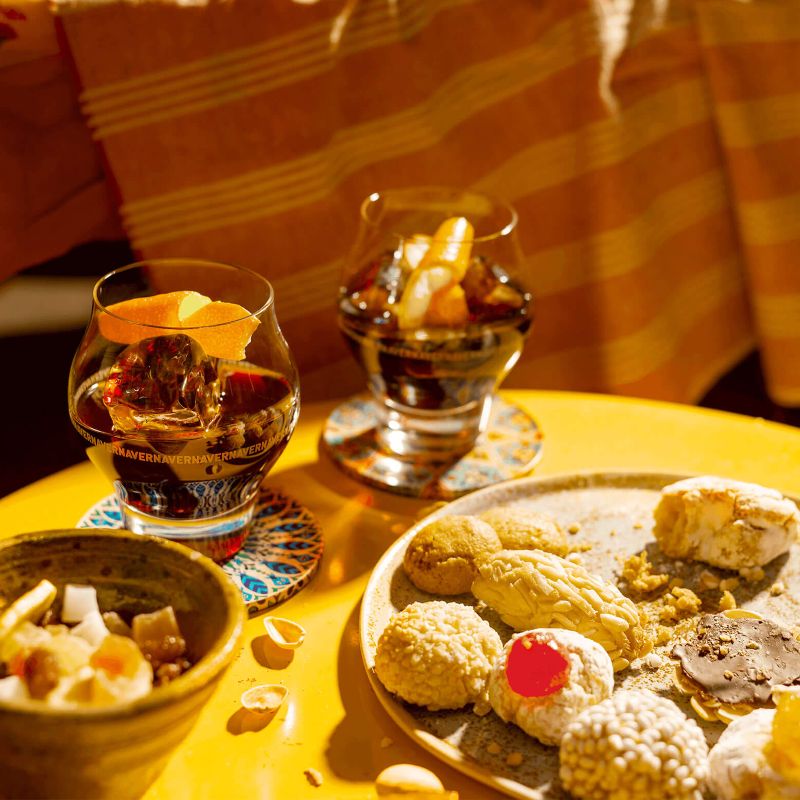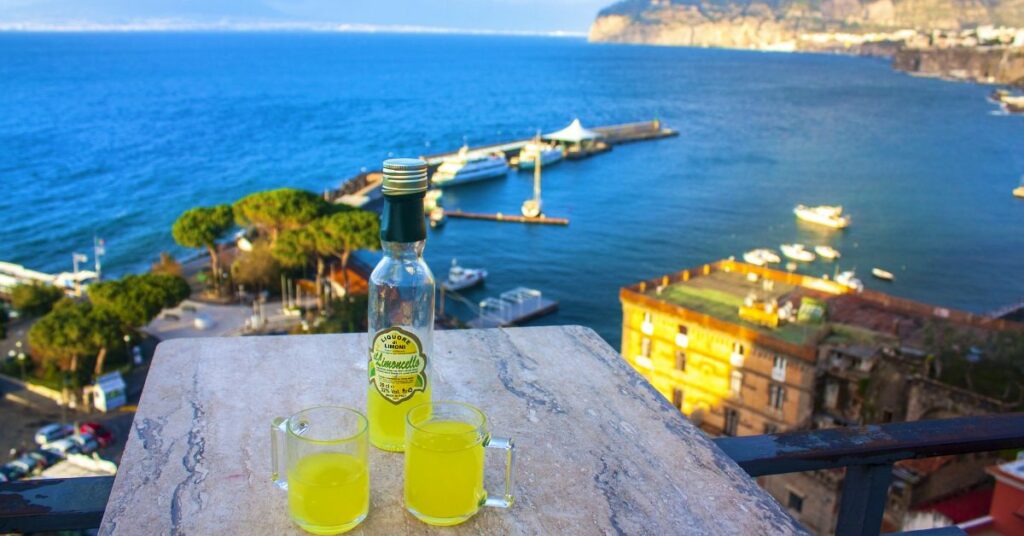After a traditional Italian dinner, you might be offered a digestivo, an Italian digestive drink.
What is a traditional Italian drink?
Digestivi are alcoholic after-dinner drinks, usually served in a small glass, straight, with perhaps one cube of ice. As the name suggests, they are meant to aid in digestion after a heavy meal.
In another post, we discussed the most famous Campari drinks, which are typically served as an aperitivo, literally meaning to “open” the appetite. In other words, before the meal. But there are many popular Italian after-dinner drinks, too. To “close” the meal, as it were.
From bitter to sweet, there’s an Italian after dinner drink to fit every palate. And with each comes a unique set of traditions and stories.
Italian Digestive After Dinner Drinks – An Overview
A digestivo (plural: digestivi) is an Italian drink, usually a liqueur, taken after dinner to aid in the digestion of food and cleanse the palate. Digestivi are usually taken straight, or served chilled in glasses with ice cubes. Some common digestivi are amaro (bitter), limoncello (sweetened lemon), and grappa (made from the must of the grapes).
One classic Italian digestive after dinner drink is Fernet Branca. It is a bitter, herbal liqueur that is enjoyed by many Italians after a meal. Other popular digestives include Grappa, Limoncello, and Sambuca.
There are many different types of digestivo, but all of them share one common goal: to help your stomach relax and get rid of any digestive discomfort.
There are many different types of digestive drinks, but the most popular is undoubtedly the amari. An amaro is an Italian herbal liqueur that is made from a variety of botanical ingredients, including herbs, spices, and roots. It has a bitter and intense flavor that can be enjoyed either on its own or mixed with other drinks.
Italian After Dinner Drinks FAQs
Did you know that amari were once bought at a pharmacy? Here are some curiosities about these ancient digestive elixirs with therapeutic properties.
The term “amaro” refers to a drink obtained by infusing herbs with a bitter taste in alcohol.
In ancient times, preparations based on alcohol and roots were used to digest long Lucullian lunches, just think of the elixir of good health recommended by Hippocrates, prepared with barley, honey and herbs added to wine.

The Medicinal Bitters
The liqueur in Europe was born in the Benedictine fortified abbeys, it was the friars, among the few who had phytotherapeutic knowledge, to prepare infusions of roots and plants in alcohol. The bitters were then administered as medicines, as stimulants in case of children’s lack of appetite or digestive.
The definition of bitter as a digestive medicine changed in 1906, due to a dispute from the American Food and Drug Administration which decreed its taxation as alcoholic and led to a collapse in sales.
Fortunately in Italy, a country where the tradition of eating well is supported by that of the end of a meal, the beneficial properties of amaro continued to be appreciated and families kept the elixir prepared at home in the pantry.
Distillers and liqueur companies brush up on ancient pharmaceutical recipes, adapting them to the taste of the current market: this is how aromatic bitters are born.
Italy still remains the producing country with the highest number of bitters in the world, ranging from vermouth to liqueurs.
The Italian After Dinner Drink Recipes
The amaro recipe was handed down by families from generation to generation, the flavor of the final elixir changes according to the plants used and the infusion time.
The medicinal plants are pounded and infused in an alcoholic solution. The liquid is then filtered and corrected with water and sugar according to the taste.
Each region and each city has its own particular amaro, sometimes linked to a local ingredient, such as the famous digestive with artichoke called Cynar.
Medicinal plants
Traditionally the most used medicinal plants are those with recognized digestive properties; such as cinchona with antibacterial activity, gentian which has the ability to inhibit Staphylococcus aureus, a bacterium responsible for skin infections, or angostura bark with an anti-tuberculosis quality. The addition of citrus fruits and bark enhances its pleasantness on the palate.
Digestion
But is it really herbs that make digestive bitterness? Yes, bitter plants increase the secretion of gastric juices and facilitate digestion. The digestive process in fact starts from the mouth, our body needs the bitter taste to stimulate the metabolic processes; the bitter taste activates the receptors in the taste buds and increases the secretion of gastrin, a hormone present in the lining of the stomach, promoting digestion.
Alchemy served. Cold and possibly after a coffee, the so-called ammazzacaffe, or “coffee killer!”
Brief History of Italian Liqueurs
As early as the 15th century, liqueurs were used as healing drinks. From the use of softening the taste of distillates by adding honey and rose oil, the preparation of sweet liquors and liqueurs, ancestors of many current products, began.
When Caterina De Medici married Enrico in 1523, she brought them to Florence to Paris together with chefs and pastry chefs, including Italian liquorists who spread the secrets of our local art of liquor in France.
A great boost to the industrial production of liqueurs came from 1700, thanks to the studies and discoveries of important scientists, who deepened their knowledge of fermentation. In the following years, the improvements obtained in sugar production gave a further boost to the liquor industry, leading Italy, France, and Holland to be the main producers of liqueurs.
Types of Liqueurs
With reference to their organoleptic characteristics, liqueurs can be divided into:
Natural Liqueurs: With well-defined taste and aroma, clearly conductive to the product used in maceration and preparation.
Fantasia liqueurs: With a particular and indefinable flavor and aroma, determined by the set of different herbs used to flavor them.
Creams: Liqueurs with a thick consistency, obtained by infusion in a low alcoholic liquid and strongly sweetened with sugar syrup.
According to a schematization based only on the evaluation of taste, we can then identify two categories of liqueurs: Dolci and Amari.
Sweet liqueurs are fancy or fruit-based liqueurs, in which the sweetness is due to the high percentage of added sugar. For example, the very popular limoncello.

The production of fruit liqueurs is done by maceration: the fruit, appropriately selected for its aromatic and sugary characteristics, is collected, cut and placed for several months to macerate in old wooden barrels with pure alcohol.
After maceration, the fruit is pressed to obtain the liquid which, after careful control, is mixed with alcohol, water, sugar, honey and a secret ingredient.
The roots, the barks, etc. instead are subjected to maceration and then distilled with alcohol in a particular still, to obtain the flavored compound which will be mixed with alcohol, liqueur and sugar.
Bitter liqueurs, or amari, are very popular in Italy, where it is customary to consume them at the end of a meal, due to their reputation as excellent digestives.
These liqueurs were born as medicinal products, intended to promote the secretion of gastric juices, thanks to the action exerted by the bitter principles extracted from plants.
The bitters can be produced with different medicinal herbs (absinthe, rhubarb, cinchona, gentian, etc.), the selection and dosage of the herbs are kept secret by the various manufacturers.
In no particular order, here are the 5 most popular Italian after dinner drinks that you’ll find at the best restaurants in Italy, or at an Italian supermarket:
What Are The Most Popular Italian After Dinner Drinks?
1. Limoncello – a lemon-flavored liqueur that is often served chilled.
2. Amaretto – a sweet almond liqueur that is also served chilled.
3. Sambuca – an anise-flavored liqueur that is often served with coffee.
4. Grappa – a strong brandy made from pomace, the residue from winemaking.
5. Amari – this represents an entire classification of bitter drinks. For example, Amaro Averna Siciliano
